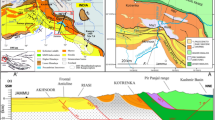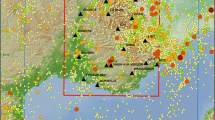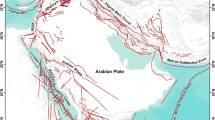Abstract
A new earthquake catalogue for central, northern and northwestern Europe with unified Mw magnitudes, in part derived from chi-square maximum likelihood regressions, forms the basis for seismic hazard calculations for the Lower Rhine Embayment. Uncertainties in the various input parameters are introduced, a detailed seismic zonation is performed and a recently developed technique for maximum expected magnitude estimation is adopted and quantified. Applying the logic tree algorithm, resulting hazard values with error estimates are obtained as fractile curves (median, 16% and 84% fractiles and mean) plotted for pga (peak ground acceleration; median values for Cologne 0.7 and 1.2 m/s2 for probabilities of exceedence of 10% and 2%, respectively, in 50 years), 0.4 s (0.8 and 1.5 m/s2) and 1.0 s (0.3 and 0.5 m/s2) pseudoacclerations, and intensity (I0 = 6.5 and 7.2). For the ground motion parameters, rock foundation is assumed. For the area near Cologne and Aachen, maps show the median and 84% fractile hazard for 2% probability of exceedence in 50 years based on pga (maximum median value about 1.5 m/s2), and 0.4 s (>2 m/s2) and 1.0 s (about 0.8 m/s2) pseudoaccelerations, all for rock. The pga 84% fractile map also has a maximum value above 2 m/s2 and shows similarities with the median map for 0.4 s. In all maps, the maximum values fall within the area 6.2–6.3° E and 50.8–50.9° N, i.e., east of Aachen.
Similar content being viewed by others
References
Adams, J. and Halchuk, S.: 2003, Fourth generation seismic hazard maps of Canada: Values for over 650 Canadian localities intended for the 2005 National Building Code of Canada, Geological Survey of Canada Open File 4459, 91 pp. + Appendices
L. Ahorner (1994) ArticleTitleFault-plane solutions and source parameters of the 1992 Roermond, The Netherlands, mainshock and its stronger aftershocks from regional seismic data Geol. Mijnbouw 73 199–214
L. Ahorner (2001) ArticleTitleAbschätzung der statistischen Wiederkehrperiode von starken Erdbeben im Gebiet von Köln auf Grund von geologisch-tektonischen Beobachtungen an aktiven Störungen Deutsche Geophysikalische Gesellschaft e.V. Mitteilungen 2 2–10
Ahorner, L. and Rosenhauer, W.: 1986, Regionale Erdbebengefährdung, In: Realistische Seismische Lastannahmen für Bauwerke, Kap. 9, Abschlußbericht an das Institut für Bautechnik Berli, König und Heinish, Beratende Ingenieure, Frankfurt/Erdbebenstation Bensberg der Universität Köln/Institut für Geophysik der Universität Stuttgart
K. Atakan A. Ojeda T. Camelbeeck M. Megraoui (2001) ArticleTitleSeismic hazard analysis results for the Lower Rhine Graben and the importance of paleoseismic data Geol. Mijnbouw 80 305–314
D. M. Boore W. B. Joyner T. E. Fumal (1997) ArticleTitleEquations for estimating horizontal response spectra and peak acceleration from western North American earthquakes: A summary of recent work Seism. Res. Lett. 68 128–153
J. P. Colbeaux C. Dupuis F. Robaszynski J. P. Auffret P. Haesaerts J. Somme (1980) ArticleTitleLe détroit du Pas-de-Calais: un élément dans la tectonique de blocs de l’Europe Nord-Occidentale Bulletin d’information des Géologues du Bassin de Paris 17 IssueID4 41–45
Coppersmith, K. J.: 1994, Conclusions regarding maximum earthquake assessment, In: The Earthquakes of Stable Continental Regions, Vol. 1. Assessment of Large Earthquake Potential, Electric Power Research Institute (EPRI) TR-102261-V1, pp. 6.1–6.24
Cornell, C. A.: 1994, Statistical analysis of maximum magnitudes, In: The Earthquakes of Stable Continental Regions, Vol. 1. Assessment of Large Earthquake Potential, Electric Power Research Institute (EPRI) TR-102261-V1, pp. 5.1–5.27
Th. Crook Particlede (1993) ArticleTitleProbabilistic seismic hazard assessment for The Netherlands Geol. Mijnbouw 72 1–13
Th. Crook Particlede (1996) ArticleTitleA seismic zoning map conforming to Eurocode 8, and practical earthquake parameter relations for The Netherlands Geol. Mijnbouw 75 11–18
A. Fäcke S. Parolai S. M. Richwalski L. Stempniewski (2006) ArticleTitleAssessing the Vibrational Frequencies of the Cathedral of Cologne (Germany) by Means of Ambient Seismic Noise Analysis Nat. Hazards 38 229–236
InstitutionalAuthorNameFRISK88M (1996) User’s Manual, Version 1.79. Risk Engineering, Inc., 4155 Darley Ave., Suite A Boulder, Colorado, USA
M. C. Geluk E. J. Th. Duin M. Dusar R. H. B. Rijkers M. W. Berg Particlevan den P. Rooijen Particlevan (1994) ArticleTitleStratigraphy and tectonics of the Roer Valley Graben Geol. Mijnbouw 73 129–141
G. Grünthal J. Schwarz (2000) Hazard-Consistent Description of Seismic Action for a New Generation of Seismic Codes, a Case Study Considering Low Seismicity Regions of Central Europe 12th World Conference Earthquake Engineering Auckland, New Zealand
G. Grünthal R. Wahlström (2001) ArticleTitleSensitivity of parameters for probabilistic seismic hazard analysis using a logic tree approach J. Earthq. Engrg. 5 309–328
G. Grünthal R. Wahlström (2003) ArticleTitleAn Mw based earthquake catalogue for central, northern and northwestern Europe using a hierarchy of magnitude conversions J. Seismol. 7 507–531 Occurrence Handle10.1023/B:JOSE.0000005715.87363.13
G. Grünthal D. Mayer-Rosa W. Lenhardt (1998) ArticleTitleAbschätzung der Erdbebengefährdung für die D-A-CH-Staaten - Deutschland, Österreich, Schweiz Bautechnik 10 19–33
Grünthal, G. and the GHSAP Region 3 Working Group: 1999, Seismic hazard assessment for Central, Northern and Northwestern Europe: GSHAP Region 3, Ann. Geofis. 42, 999–1011.
R. Legrand (1968) ArticleTitleLe Massif de Brabant Mémoires pour servir à l’explication des Cartes géologiques et minières de la Belgique 9 148 pp
D. Leynaud D. Jongmans H. Teerlynck T. Camelbeeck (2000) ArticleTitleSeismic hazard assessment in Belgium Geol. Belgica 3 IssueID1–2 67–86
I. Main D. Irving R. Musson A. Reading (1999) ArticleTitleConstraints on the frequency–magnitude relation and maximum magnitudes in the UK from observed seismicity and glacio-isostatic recovery rates Geophys. J. Int. 137 535–550 Occurrence Handle10.1046/j.1365-246X.1999.00796.x
S. M. Richwalski A. Fäcke S. Parolai L. Stempniewski (2003) ArticleTitleInfluence of Site and Source Dependent Ground Motion Scenarios on the Seismic Safety of Long-span Bridges in Cologne, Germany Nat. Hazards 38 237–246
J. Schwarz G. Grünthal Ch. Golbs (2001) ArticleTitleGefährdungskonsistente Erdbebenwirkungen für deutsche Erdbebengebiete – Konsequenzen für die Normenentwicklung Thesis 1/2, Wiss. Zeitschrift der Bauhaus-Universität Weimar 47 50–69
Schwarz, J., Raschke, M., and Gerstberger, A.: 2002, Seismische Schadenspotentiale in deutschen Großstadträumen – Fallstudie Köln. In: K. Meskouris and K. -G. Hinzen (eds), Schutz von Bauten gegen natürliche und technische Erschütterungen, Vol. 11, DGEB-Publikation, pp. 69–83
J. Schwarz M. Raschke H. Maiwald (2006) ArticleTitleComparative Seismic Risk Studies for German Earthquake Regions on the Basis of the European Macroseismic Scale EMS-98 Nat. Hazards 38 259–282
W. Sponheuer (1960) ArticleTitleMethoden zur Herdtiefenbestimmung in der Makroseismik Freib. Forschungsh. C88 117 pp
P. Spudich W. B. Joyner A. G. Lindh D. M. Boore B. M. Margaris J. B. Fletcher (1999) ArticleTitleSEA99: A revised ground motion prediction relation for use in extensional tectonic regimes Bull. Seism. Soc. Am. 89 1156–1170
D. Stromeyer G. Grünthal R. Wahlström (2004) ArticleTitleChi-square maximum likelihood regressions for seismic strength parameter relations, and their uncertainties, with applications to an Mw based earthquake catalogue for central, northern and northwestern Europe J. Seismol. 8 143–153 Occurrence Handle10.1023/B:JOSE.0000009503.80673.51
R. Wahlström G. Grünthal (2000) ArticleTitleProbabilistic seismic hazard assessment (horizontal PGA) for Sweden, Finland and Denmark using different logic tree approaches Soil Dyn. Earthq. Engrg. 20 45–58
R. Wahlström G. Grünthal (2001) ArticleTitleProbabilistic seismic hazard assessment (horizontal PGA) for Fennoscandia using the logic tree approach for regionalization and nonregionalization models Seism. Res. Lett. 72 32–44
D. L. Wells K. J. Coppersmith (1994) ArticleTitleNew empirical relationships among magnitude, rupture length, rupture width, rupture area, and surface displacement Bull. Seism. Soc. Am. 84 974–1002
Author information
Authors and Affiliations
Corresponding author
Rights and permissions
About this article
Cite this article
Grünthal, G., Wahlström, R. New Generation of Probabilistic Seismic Hazard Assessment for the Area Cologne/Aachen Considering the Uncertainties of the Input Data. Nat Hazards 38, 159–176 (2006). https://doi.org/10.1007/s11069-005-8611-7
Received:
Accepted:
Issue Date:
DOI: https://doi.org/10.1007/s11069-005-8611-7




